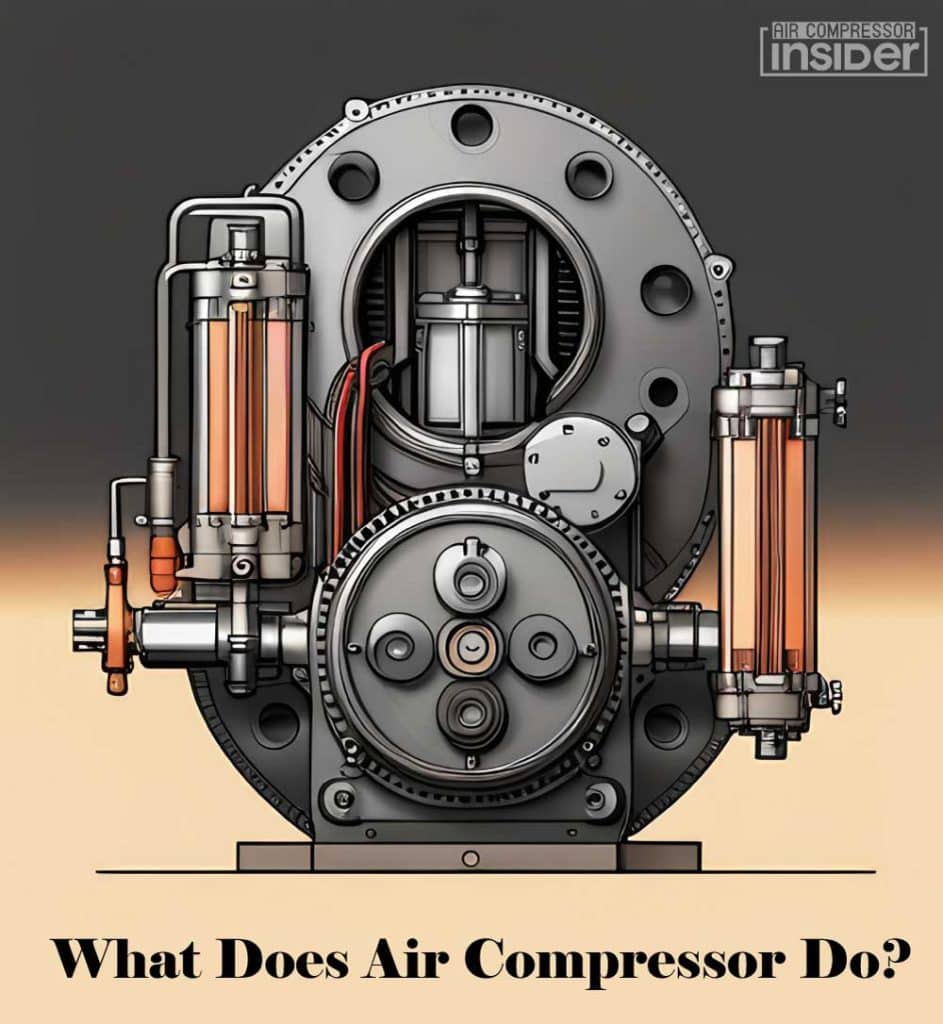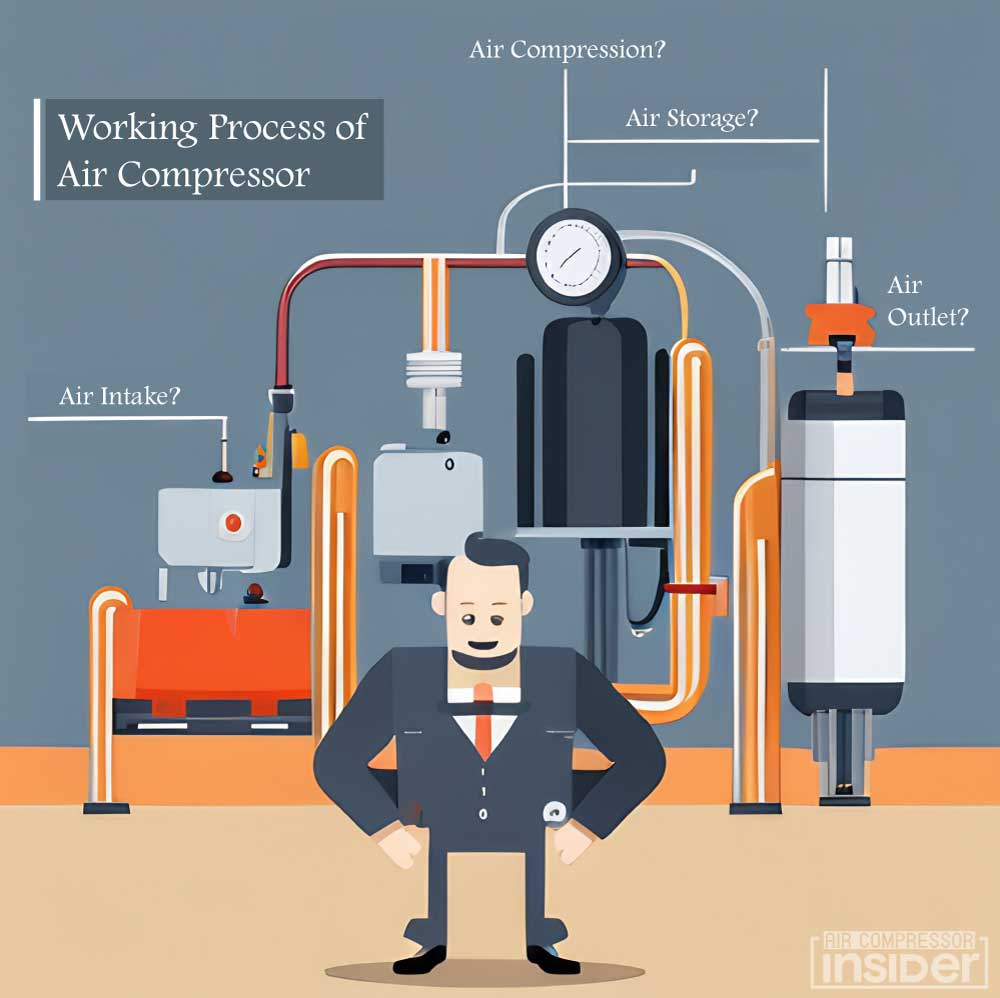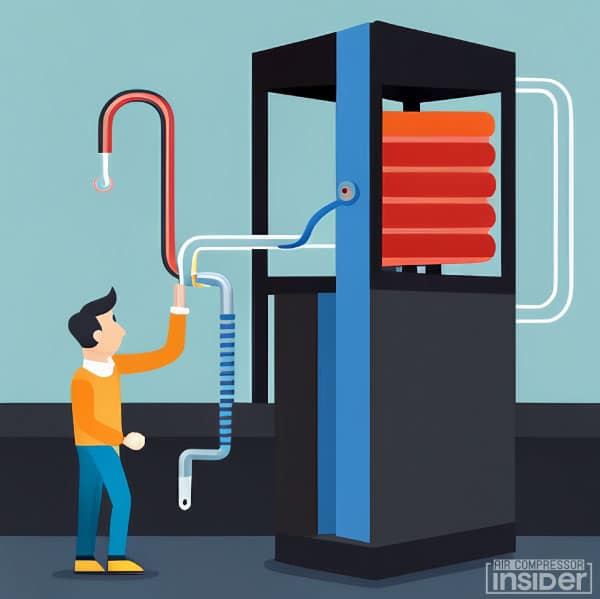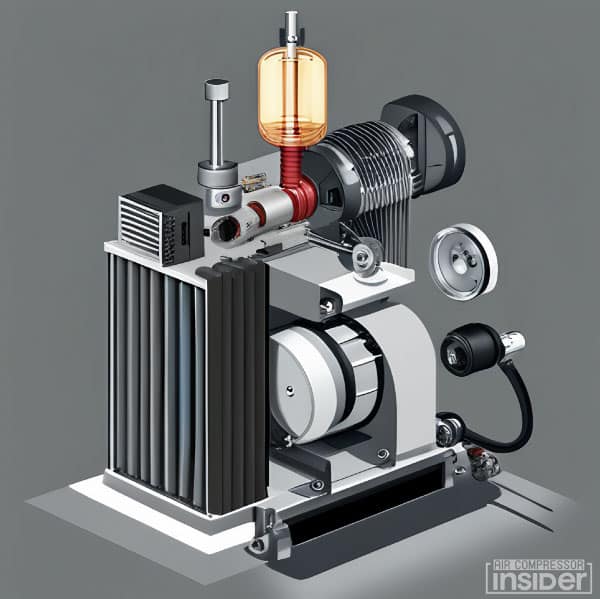What Is An Air Compressor?
Air compressors are powerful devices that convert power into potential energy stored in pressurized, or compressed, air.
This is achieved by forcing air into a container and reducing its volume. When the compressed air is released, it expands, and this rapid expansion allows it to be used for a variety of purposes.
These applications range from simple household tasks like inflating tires and toys, to more complex industrial functions such as running pneumatic-tools, HVAC control systems, and even large-scale operations in manufacturing plants.
There are several types of air compressors, including piston-type, rotary screw, and centrifugal, each with unique characteristics and suited for different tasks.
Understanding the specifications and functionalities of these different types can help you select the right size air compressor for your specific needs.

- What Is An Air Compressor?
- Working Process Of Air Compressor:
- What Is Air Displacement In Air Compressor?
- Types of Air Compressors:
- Stage Types Of Air Compressor:
- Benefits of Using an Air Compressor:
- How Does an Air Compressor Work?
- Uses Of Air Compressor In Different Industries:
- 1. Construction:
- 2. Automotive Repair:
- 3. Manufacturing:
- 4. Industrial:
- 5. Painting and Coating:
- 6. Food Processing:
- 7. Waste Management:
- 8. Power Generation and Distribution:
- 9. Refrigeration and HVAC:
- 10. Mining and Drilling:
- 11. Tire Inflation and Automation:
- 12. Healthcare:
- 13. Aerospace:
- 14. Textile Manufacturing:
- Different Uses Of Air Compressor:
- Different Ways To Power An Air Compressor:
- Common Problems With Air Compressors and How to Troubleshoot Them:
- Maintaining Your Air Compressor:
An air compressor is widely used in many industries, powering a range of machinery and equipment.
Fundamentally, it works by capturing air, compressing it to increase its pressure, and storing it in a compressed state for future use.
This high-pressure air can then be used to power many air-tools and machines, from pneumatic drills to HVAC systems.
Efficient and versatile, air compressors form an integral part of modern manufacturing, construction, and automotive industries, among others.
What Does Air Compressor Do
An air compressor functions by drawing air from the environment into a storage tank, using the power of an electric motor or gasoline engine.
This air is then pressurized within the tank. When the air pressure in the tank reaches a predetermined level, the compressor shuts off.
The pressurized air is then ready to be used for various applications, such as inflating tires, powering airtools, or cleaning equipment.
It’s important to note that the air inside the tank is under high pressure, and safety measures should be taken during its release and usage.
Working Process Of Air Compressor:

1. Intake:
An air compressor starts its process with the intake of air through an inlet valve. Ambient air is sucked into the compressor where it gets trapped.
2. Compression:
The absorbed air is then transferred to the compression chamber. Here, the air is compressed by a piston which moves up and down. When the piston moves down, it creates a vacuum, pulling more air into the chamber. As the piston moves up, the air is compressed.
3. Storage:
The compressed air is then pushed into a storage tank. A sensor in the tank signals the compressor to stop compressing once the tank is full.
4. Outlet:
When a tool connected to the air compressor is used, the compressed air from the storage tank is released through an outlet valve. The pressure of the released air powers the tool.
5. Cycle repetition:
Once the air pressure in the tank drops below a preset level, the compressor turns back on and the cycle repeats. The cycle of intake, compression, storage, and outlet continues as long as the compressor is in operation.
What Is Air Displacement In Air Compressor?

Air displacement in an air compressor refers to the amount of air that a compressor can suck in, compress, and then expel.
This process is measured in cubic feet per minute (CFM). The greater the CFM, the more air an air compressor can process, and the more powerful it is considered to be.
This key metric indicates the efficiency and capacity of the air compressor, helping users determine which model is best suited for their specific needs.
The quality of the air compressor is also determined by the amount of air it can displace.
This is because a higher CFM rating indicates that more work will be possible using the same amount of power as a lower-rated model.
Additionally, higher displacement rates mean faster filling times for pressure tanks, allowing users to complete tasks without having to wait long periods of time.
With this in mind, it is essential to consider the CFM rating when selecting an air compressor. The overall size and weight of a compressor also contributes to its displacement capabilities.
Larger compressors generally have higher displacement ratings due to their greater tank capacity and pumping power.
Additionally, oil-lubricated models tend to produce more compressed air than oil-free models, making them ideal for industrial or heavy-duty applications.
Ultimately, understanding air displacement in an air compressor can help users choose the right model to meet their specific requirements.
Additionally, it is important to ensure that you have all of the necessary safety precautions in place while operating any type of air compressor.
By considering both the CFM rating and size of an air compressor, users can choose the most suitable model for their needs. Doing so will help ensure a safe and efficient operation.
Types of Air Compressors:
There are three primary types of air compressors, each with unique mechanisms and applications.
1. Reciprocating Air Compressors:
These are most commonly used in garages and workshops. They operate via a piston within a cylinder to compress and deliver air at high pressure.
2. Rotary Screw Compressors:
These are used in high production settings like factories and industrial plants. They generate compressed air by two rotors within a casing.
3. Centrifugal Compressors:
These are typically used in extremely high capacity applications such as power plants and oil refineries. They use high-speed rotating impellers to make air.
Choosing the right type of air compressor depends largely on its intended use and the demands of the task at hand.
Stage Types Of Air Compressor:
Air compressors can be classified into different types based on the number of stages involved in the compression process. These are primarily divided into single-stage and multi-stage compressors.
Single-stage air compressors:
Single-stage air compressors work by drawing in air and compressing it to its final pressure in just one piston stroke. These compressors are generally used for lighter, home-based applications such as inflating tires or powering airbrushes.
Two-stage air compressors:
Two-stage air compressors on the other hand, have two pistons that compress the air in separate stages. This allows for a higher pressure and flow rate than a single-stage compressor, making it better suited for heavy-duty industrial applications such as automotive repair or painting.
Understanding the stage types of air compressors aids in selecting the right compressor according to the specific needs and capacities of the application.
Benefits of Using an Air Compressor:
There are many benefits that come with using an air compressor that make it a great choice for your home or business.
1. Versatility:
Air compressors are incredibly versatile tools that can be used for a variety of tasks. Whether you need to blow up a tire, power a tool, or perform any other task that requires pressurized air, an air compressor is the perfect device for the job.
2. Efficiency:
Air compressors are designed to operate efficiently and economically. They use less energy, produce fewer emissions, and help reduce operational costs. This makes them a great choice for businesses looking to save on energy bills.
3. Safety:
Air compressors are designed to be safe to use, and can be operated safely by both experienced and inexperienced operators alike. This makes them an ideal choice for those who need to perform tasks that require pressurized air in a safe and secure manner.
4. Durability:
Air compressors are designed to last, with many models being able to withstand the rigors of industrial use for years without needing maintenance or repairs. This makes them an excellent choice for businesses that need reliable, long-term solutions for pressurized air operations.
5. Cost Savings:
Air compressors can help you save money by reducing your energy usage and eliminating the need for costly repairs or maintenance. Air compressors are also a great choice for businesses that require large amounts of pressurized air, as they can operate at lower costs than traditional gas-powered solutions.
Overall, air compressors are a great tool to have in any home or business environment. From their versatility to their cost savings, air compressors offer a wide range of benefits that make them an invaluable asset. Whether you’re looking for a cost-saving solution or just need the right tool for the job, an air compressor is sure to get the job done.
How Does an Air Compressor Work?

An air compressor functions by utilizing the principle of Boyle’s law, which states that under constant temperature, the volume of a gas is inversely proportional to its pressure.
The process begins when the compressor’s motor starts up, driving the pump which then draws in ambient air through an intake valve.
This air is subsequently trapped in a confined space, which leads to an increase in its pressure.
This compressed air is then stored in a tank, building up until it reaches the maximum level determined by the compressor’s design.
Once the air reaches the desired pressure level, it can be used to power various tools or applications, such as pneumatic drills or paint sprayers, upon release.
Uses Of Air Compressor In Different Industries:
Air compressors are used in a variety of industries, from manufacturing and construction to automotive repair.
They are an essential tool for powering pneumatic tools and performing many other tasks that require compressed air.
1. Construction
2. Automotive Repair
3. Manufacturing
4. Industrial
5. Painting and Coating
6. Food Processing
7. Waste Management
8. Power Generation and Distribution
9. Refrigeration and HVAC
10. Mining and Drilling
11. Tire Inflation and Automation
12. Healthcare
13. Aerospace
14. Textile Manufacturing
1. Construction:
Air compressors are used in the construction industry for a variety of tasks, such as powering pneumatic tools, painting, sandblasting, welding, and other tasks that require compressed air.
2. Automotive Repair:
Air compressors are used in automotive repair shops to power pneumatic tools for tasks such as tire repairs and suspension work. They can also be used for painting, sandblasting, and other tasks that require compressed air.
3. Manufacturing:
Air compressors are used in manufacturing operations to power pneumatic tools such as drills and screwdrivers. They can also be used to power automated assembly lines and other manufacturing processes that require compressed air.
4. Industrial:
Air compressors are used in industrial applications to power pneumatic tools such as drills and screwdrivers. They can also be used for tasks such as welding, sandblasting, painting, and other tasks that require compressed air.
5. Painting and Coating:
Air compressors are used in the painting and coating industry to power pneumatic tools such as paint guns and sprayers. They can also be used for tasks such as sandblasting, welding, and other tasks that require compressed air.
6. Food Processing:
Air compressors are used in the food processing industry to power pneumatic tools such as drills and screwdrivers. They can also be used for tasks such as cleaning and sanitizing, mixing and blending, and other tasks that require compressed air.
7. Waste Management:
Air compressors are used in the waste management industry to power pneumatic tools such as drills and screwdrivers. They can also be used for tasks such as material handling, sorting, conveying, and other tasks that require compressed air.
8. Power Generation and Distribution:
Air compressors are used in the power generation and distribution industry to power pneumatic tools such as drills and screwdrivers. They can also be used for tasks such as maintenance, repair, and inspection work that require compressed air.
9. Refrigeration and HVAC:
Air compressors are used in the refrigeration and HVAC industry to power pneumatic tools such as drills and screwdrivers. They can also be used for tasks such as maintenance, repair, and inspection work that require compressed air.
10. Mining and Drilling:
Air compressors are used in the mining and drilling industry to power pneumatic tools such as drills and screwdrivers. They can also be used for tasks such as material handling, sorting, and conveying that require compressed air.
11. Tire Inflation and Automation:
Air compressors are used in the tire inflation and automation industry to power pneumatic tools such as drills and screwdrivers. They can also be used for tasks such as tire maintenance, repair, and inspection work that require compressed air.
12. Healthcare:
Air compressors are used in the healthcare industry to power pneumatic tools such as drills and screwdrivers. They can also be used for tasks such as sterilization, cleaning, and general maintenance that require compressed air.
13. Aerospace:
Air compressors are used in the aerospace industry to power pneumatic tools such as drills and screwdrivers. They can also be used for tasks such as testing, maintenance, and repair work that require compressed air.
14. Textile Manufacturing:
Air compressors are used in the textile manufacturing industry to power pneumatic tools such as drills and screwdrivers. They can also be used for tasks such as cutting, stitching, bonding, and other tasks that require compressed air.
Air compressors are an essential tool for powering pneumatic tools and performing many other tasks that require compressed air across multiple industries.
With advances in technology, they are now more efficient and powerful than ever before, making them a must-have for any business or industry that needs to use compressed air on a regular basis.
Air compressors are available in a variety of sizes and styles to suit any application, ensuring that you will always have the right tool for the job.
Different Uses Of Air Compressor:
Air compressors are versatile tools with a wide range of applications across various industries.
1. Pneumatic Tools:
Air compressors provide power to a variety of pneumatic tools such as nail guns, paint sprayers, and sandblasters, making tasks more efficient and less labor-intensive.
2. HVAC Systems:
They play a crucial role in heating, ventilating, and air conditioning (HVAC) systems, helping in the heat exchange process to maintain optimal indoor temperatures.
3. Automotive Industry:
In the automotive industry, air compressors are used for inflating tires and powering air brake systems in large vehicles and trains.
4. Manufacturing:
Many manufacturing processes, such as those in the food and beverage industry, rely on air compressors for tasks such as packaging, bottling, and even cutting and shaping materials.
5. Medical Field:
In the medical field, air compressors are used in various equipment, including dental drills and oxygen concentrators for patients with respiratory issues.
These are just a few examples illustrating the broad utility of air compressors in diverse fields.
Different Ways To Power An Air Compressor:
Air compressors can be powered by a variety of energy sources, each with its own advantages and disadvantages.
1. Electricity:
This is the most common power source for air compressors due to its widespread availability and ease of use. However, electrical air compressors require a steady power source, which may not be available in all locations.
2. Gasoline:
For areas without a reliable electricity source, gasoline-powered air compressors are an excellent alternative. These compressors are portable and powerful, but they emit exhaust fumes and can be noisy.
3. Diesel:
Diesel-powered compressors are typically used for heavy-duty applications. They provide a high power output and are highly durable, but they are also noisy and produce emissions.
4. Natural Gas:
In some industrial applications, natural gas-powered air compressors are used. These compressors utilize the existing natural gas supply, making them cost-effective and environmentally friendly. However, they require a constant supply of natural gas and are not portable.
Each of these power options has its own set of considerations, such as cost, availability, and environmental impact.
The choice of power source depends largely on the specific requirements of the task at hand. An air compressor is a versatile tool with numerous applications.
At its core, it functions by converting power, usually from an electric motor, into potential energy stored in pressurized, or compressed, air.
This stored energy can then be used to power a variety of tools and equipment.
From inflating tires and powering pneumatic tools like nail guns or paint sprayers, to being a crucial component in HVAC systems, air compressors are a fundamental part of many domestic and industrial operations.
They are also used in the production and transport of gases, offering an efficient way to safely store and transport energy.
In addition to being used for a variety of tools and equipment, air compressors can also be used to power other machines like vacuum pumps or turbines.
This makes them invaluable in the manufacturing industry, where they are often utilized to provide power for automated processes such as shaping and cutting metal.
Furthermore, in many cases, compressed air is used instead of electricity when powering machines, as it is a cleaner and more reliable energy source.
Overall, air compressors are an important component in any powered system.
Whether you’re powering tools for home projects or running automated systems in manufacturing plants, air compressors provide a safe and efficient way to power the equipment you need.
Air compressors have also become increasingly popular in the automotive industry due to their ability to power a wide range of functions.
From powering radiators or air conditioning systems, to providing the fuel for internal combustion engines, air compressors are becoming an increasingly common sight in car showrooms and service centers across the country.
Common Problems With Air Compressors and How to Troubleshoot Them:
Sometime air compressors can cause problems that can be troublesome to troubleshoot. Here some of the more common issues and how you can diagnose and fix them.
1. Leaking Air:
If your air compressor is leaking air, it could be a problem with the gaskets or seals around the air intake valve or pressure release valve. Check for any signs of damage or deterioration, and if needed replace them. If the problem persists, it could be a more serious issue such as an internal air leak or damaged cylinder head.
2. Oil Leaks:
Air compressors use oil for lubrication and cooling, so any sign of leaking oil should be investigated to prevent further damage to the system. Look for areas around the pump, motor and in the air lines that might be leaking. If you find a leak, it could mean there is something wrong with the pump or the sealant used to connect components together.
3. Pressure Problems:
Air pressure problems can occur if the pressure relief valve isn’t set correctly or if the regulator malfunctions. Make sure the pressure relief valve is adjusted properly and that all hoses and fittings are secure. If the pressure problems persist, it could be a sign of a larger problem with the motor or pump.
4. High Temperature:
In many cases, high temperatures can be caused by an overworked air compressor that is being overloaded with air pressure. Check to make sure that your compressor isn’t too small for the job you’re asking it to do, and that all intake valves are closed when not in use. Make sure that the air intake filter is clean and replace if needed. If the problem continues, check for any signs of an internal blockage or a worn pump.
5. Unusual Noises:
All air compressors make noise, but if you start hearing something out of the ordinary – like rattling, grinding or squealing – it could be a sign of an internal problem with the air compressor.
Make sure all screws and bolts are tight, as loose connections can cause unusual noises. Replace any worn hoses or valves if needed.
If the sound continues, then you should call a professional for further inspection and repairs. By following these troubleshooting tips you can quickly diagnose and fix many common air compressor problems.
With a little patience and the right tools, you can get your air compressor up and running again in no time.
Maintaining Your Air Compressor:
Air compressors, much like other machinery, require regular upkeep to ensure their optimal functionality and longevity.
1. Perform Regular Inspections and Cleanings:
This is an important part of maintaining your air compressor. Make sure to check for any cracks or worn parts, hoses, belts, etc.
If you notice anything off, have a qualified professional make the necessary repairs before using the machine again.
Additionally, clean the air filter regularly as it can become clogged with dust and dirt which can hinder the air flow.
2. Use the Right Grade of Oil:
Using a higher grade oil can help prevent sludge buildup, which can cause your compressor to malfunction and reduce its lifespan.
Make sure to check your manufacturer’s instructions for the right type and amount of oil to use.
3. Drain Your Tank Regularly:
Draining your tank regularly prevents moisture buildup, which could cause your compressor to rust.
If you’re using a portable unit with an oil-lubricated motor, make sure to check the oil level as well.
4. Store Properly:
When not in use, it is important to store your air compressor properly. Keep it in a cool and dry area where there is plenty of air circulation.
Additionally, ensure that all hoses and connections are secured and tight to prevent possible accidents or leaks.
With a bit of effort and care, you can maintain your air compressor for optimal performance and longevity. Sticking to a regular maintenance schedule will help you avoid any major problems down the line.
And if something does go wrong, make sure to call a qualified technician to take care of it.
Never attempt repairs or maintenance if you don’t feel comfortable with the task.
